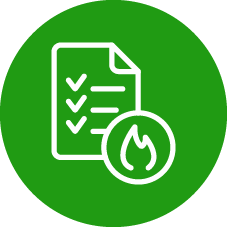GEEPs and PEEPs
Emergency fire and evacuation plans built to save lives
Some employers and organisations are led to believe that the building plan and layout are all you need to create an evacuation plan. Fact is, it couldn’t be further from the truth. Evacuation plans should be tailored to the specific requirements and individuals in the workplace.
Since the introduction of the Regulatory Reform (Fire Safety) Order 2005, employers and organisations are responsible for making sure that everyone can evacuate the building safely if there is a fire or emergency. This includes those at additional risks, such as the disabled, vulnerable and mobility impaired.
This is where GEEPs and PEEPs come in. Knowing what to do in an emergency is important, and being able to evacuate your building safely and effectively is essential for protecting others.
At The Health & Safety Dept, we can draw up bespoke emergency fire and evacuation plans for your business, giving you peace of mind that your evacuation plans are robust, effective and expertly designed.
What is a General Emergency Evacuation Plan (GEEP)?
A General Emergency Evacuation Plan is a plan that highlights a building’s layout, evacuation procedures, equipment and communication devices used in an emergency. While they are useful for all visitors, GEEPs are designed to give visitors with restricted mobility, or those who can’t evacuate unaided, the information they need to do so safely and effectively.
In a public building, a GEEP must be in place for all visitors to see. And everything outlined, such as the evacuation procedures, should be visible with notices for those who may need assistance. Regular drills and a system to test the methods must be in place to ensure all the staff are aware of the procedures and have adequate training and knowledge of the building’s layout and equipment.
What is a Personal Emergency Evacuation Plan (PEEP)?
A PEEP is a Personal Emergency Evacuation Plan. This bespoke ‘escape plan’ is for individuals who may not be able to reach a point of safety unaided, or within an adequate amount of time, during an emergency.
Unlike a GEEP, a PEEP is tailor-made for an individual to secure their safety in the event of an emergency evacuation. The plan must be drawn up with the individual so that the evacuation method can be agreed upon. As well as detailing the escape routes, the PEEP will identify the people who will assist in the evacuation and training.
Similar to a GEEP, the plan should be regularly tested to ensure all staff are familiar with the procedure and have adequate training and knowledge in the building’s equipment and layout. The PEEP should be distributed to everyone involved and filed accordingly.
How do I know if I need a GEEP or PEEP?
If your business allows people on-site, whether it’s customers or employees, you will need a GEEP. It’s that simple.
Knowing whether you need a PEEP, however, isn’t as straightforward. To ensure the right outcome, you should ask yourself, “Can the employee or regular visitor evacuate the building unaided, promptly, during an emergency?” If the answer to that question is “no”, a PEEP is needed.
There are two types of PEEPs: permanent and temporary. A permanent PEEP is needed for any person who has:
- Mobility impairments
- Sight impairments
- Hearing impairments
- Cognitive impairments
- Other relevant circumstances
A temporary PEEP is for anyone with:
- Short-term injuries (i.e., a broken leg)
- Temporary medical conditions
- Those in the later stages of pregnancy
At The Health & Safety Dept, we’re on hand to help draw up your emergency fire and evacuation plans that are tailored to your business, sites and operations. Whether it’s a PEEP or a GEEP, we’ll ensure your plans are robust, effective and expertly designed.
Give us a call to find out how we can bring peace of mind to your business.
What should a Personal Emergency Evacuation Plan include?
A Personal Emergency Evacuation Plan will be unique to your business and the individual, but here is a list of everything that needs to be covered when drawing up a PEEP:
- Identify everyone who may need assistance, including anyone who is temporarily impaired.
- Make the evacuation procedures visible with notices for those who need assistance.
- Carry out regular drills and put a system in place to test the methods. The person who needs assistance should be informed of their involvement and when it is needed.
- Ensure the PEEP is created with the person who will be needing assistance and everyone assisting.
- PEEPs should be reviewed regularly to ensure they are still relevant and suitable.
- All class 1 medical devices e.g wheelchairs and hoists must be maintained and regularly inspected.
- PEEPs must be recorded and filed.
At The Health & Safety Dept, we can draw you up a robust PEEP that’s tailored, ensures the safety of your visitors and employees, and complies with fire safety regulations. Having this plan in place will give your employees and visitors peace of mind that should an emergency happen, you are well prepared to handle the evacuation.
Does everyone with a disability need a PEEP?
A PEEP isn’t needed for everyone with a disability or an impairment.
If the individual can leave the building unaided safely and within an acceptable period of time, they will not need a Personal Emergency Evacuation Plan. However, it’s always best to speak to the individual before settling on a decision, because while they may not have a problem entering and exiting the building, they may need assistance in an emergency.
GEEPs and PEEPs FAQ
Who needs a personal emergency evacuation plan?
There are two types of PEEP: permanent and temporary. A permanent PEEP is required for anyone who has mobility, sight, hearing or cognitive impairments, or any other relevant circumstances. For short-term injuries such as a broken leg, or temporary medical conditions and those in the later stages of pregnancy, a temporary PEEP is required.
What does a personal evacuation plan cover?
The main thing a PEEP needs to detail at the planning stage is the necessary escape route(s). This includes clear unobstructed gangways and floor layouts. The individual must also be able to operate any security devices on doors in the event of an emergency, so these must feature in the PEEP too.
How do I prepare for a GEEP and PEEP?
GEEPS and PEEPS can become quite complex as you consider your environment, the people and behaviour during an emergency. It is very easy to miss something that could later on cost a life. To help you prepare a Geep or Peep The Health & Safety can guide and support you through the process to give you peace of mind that your GEEP and PEEP is correct.
Will my GEEP and PEEP need to be checked regularly?
At The Health & Safety Dept, we recommend that you review your GEEPs and PEEPs at least annually to ensure they are still relevant to your visitors and employees (a person’s situation may change or the building layout may alter).

Related Services

Fire Risk Assessment

Safe Systems of Work

Policies & Procedures

Looking for expert health & Safety support?
We can help you focus on your business by taking care of all your health & safety needs.
Let us know how we can help or ask about our free initial H&S review.
Sensible Safety Solutions
Subscribe to our newsletter
Office Address: 5 South Charlotte Street, Edinburgh, EH2 4AN | VAT Number: 189940449 | Registration Number: SC476281
Copyright © 2007 – 2019 The H&S Dept Ltd. H&S DEPT is a registered trademark belonging to The H&S Dept Limited.

